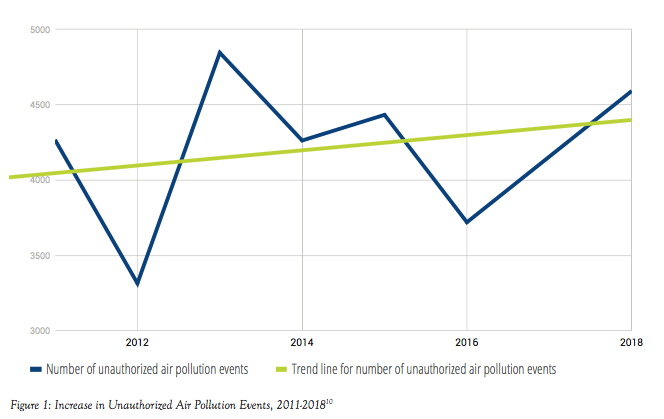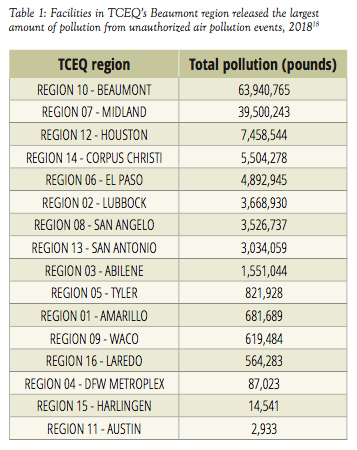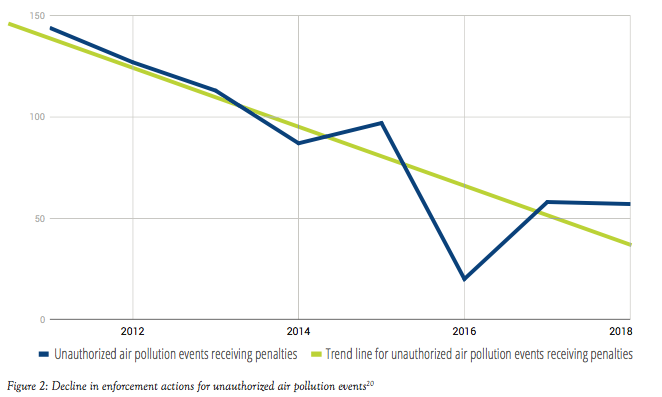Illegal Air Pollution in Texas
Air pollution from startups, shutdowns, malfunctions and maintenance at industrial facilities in Texas in 2018
In 2018, 267 companies reported 4,590 breakdowns, maintenance incidents, and other unauthorized air pollution events that resulted in the release of more than 135 million pounds of illegal air pollution — more than double the amount of unauthorized emissions released the year before.
Downloads
On May 19, 2018, an explosion and flash fire ignited at Kuraray America EVAL’s Pasadena plant, injuring 21 people and sending thousands of pounds of unauthorized pollution into the air. Emergency response rushed injured workers to the hospital – some by ambulance, some by helicopter –and as the reports rolled in, officials counted a total of approximately 270 workers on-site that day.
According to self-reported company data filed with the Texas Commission on Environmental Quality (TCEQ), the fire began when pressure in the facility’s reactor triggered a safety valve release, emitting over 2,000
pounds of highly flammable gas. News reports indicate that the gas then ignited upon contact with a contractor’s welding equipment, triggering the explosion.
“Emissions events” or “upsets” are the regulatory terms used to describe this event – just one of the thousands of times industrial facilities violate their Clean Air Act permits each year. These unauthorized air pollution events, caused by equipment breakdowns, process malfunctions, operator errors, startups, shutdowns or maintenance work, are supposed to be accidental, unanticipated releases of air pollution. However, the data show that these events occur so frequently as to be almost routine at some facilities, and often involve large releases of health threatening pollution, such as benzene and particulate matter.
Unauthorized emissions more than doubled between 2017 and 2018
- In 2018, 267 companies reported 4,590 breakdowns, maintenance incidents, and other unauthorized air pollution events that resulted in the release of more than 135 million pounds of illegal air pollution — more than double the amount of unauthorized emissions released the year before.
- The sharp increase in unauthorized emissions between 2017 and 2018 can be attributed, in large part, to a single emissions event at the Beaumont Gas to Gasoline Plant in Jefferson county — a facility that plans to become the largest methanol plant in the U.S. The event, which began during equipment startup at the plant on August 29, 2018, lasted for more than 5 days and emitted over 53 million pounds of carbon dioxide pollution – the equivalent of adding 369,000 passenger vehicles to the roads for that duration. While illegal emissions of greenhouse gasses are likely drastically underrepresented by STEERS reports, the increase in reported illegal conventional pollutant emissions such as benzene or nitrogen oxide is not as drastic as it appears. However, statewide emissions rose even without this emissions event.

Illegal pollution raises concerns about threats to health and environment.
- A recent study found that emissions events in Texas lead to the premature deaths of at least 42 people and $241 million in health-related costs per year.
- A resident of Midland County, Texas filed a complaint with TCEQ on June 6, 2018, stating that “fracking across the street creates oily frac dust to settle on everything! My dogs have to walk in the grass, they constantly lick their feet… We come in from outside and cough and sneeze.” They also noted that “trees in the back yard are dying.” TCEQ’s Midland region ranked second for total pounds of pollution released in 2018 via unauthorized air pollution events.
- A resident of Ector County, Texas, filed a complaint with TCEQ on January 25, 2018, “reporting at least 10 birds, pigeons, are dead under… [a] bridge.” The resident continued, stating that they believe “the birds’ deaths … result… from oil and gas sites located throughout the area.” Multiple facilities in Ector County ranked in the top 10 lists for dangerous pollutants in the state, including hydrogen sulfide and sulfur dioxide.
Petrochemical facilities top lists of biggest illegal polluters
- Two Houston-area facilities — Chevron Phillips Chemical Cedar Bayou Plant and Pasadena Refining System — were the two largest emitters of benzene, a known carcinogen, in the state in 2018 via unauthorized air pollution events.
- Newpark Drilling Fluids’ facility in Kenedy had the highest unauthorized emissions of particulate matter in 2018, via unauthorized air pollution events. Particulate matter is linked to a range of cardiovascular problems, including heart attacks, strokes, and congestive heart failure. Phillips 66’s oil refinery in Borger and 1776 Energy Operators’ crude oil storage facility in Karnes County emitted the next highest amounts of particulate matter.

Enforcement actions continue to decline
- The number of TCEQ enforcement actions against unauthorized air pollution events declined from 2017 to 2018, even as the volume of emissions more than doubled. Looking back over the last eight years, the total number of emissions violations resulting in penalties by TCEQ and the State of Texas is just 2 percent of the total number of unauthorized events recorded by the agency in that time.
- In 2018, TCEQ and the State of Texas financially penalized companies for approximately 57 unauthorized air pollution events (that occurred before 2018), compared with 4,590 unauthorized air pollution events reported in 2018.
Polluters continue to escape financial penalties via the affirmative defense loophole
- According to TCEQ data analyzed by EIP, companies claimed the affirmative defense, a loophole which allows polluters to escape financial penalties if they meet certain criteria 97% of the time in 2018.
- In previous years, the EPA has ruled against the legitimacy of the affirmative defense. However, the current EPA administration is attempting to revoke that position, arguing in favor of the affirmative defense. In the few cases when fines are issued at all, the fines are on average a fraction of what TCEQ is authorized to levy.
- In 2018, TCEQ and the State of Texas fined companies approximately $1.8 million for unauthorized air pollution events. When compared to the total pounds of air pollutants released by unauthorized events in 2018, TCEQ and the State of Texas fined companies approximately $0.013 per pound of unauthorized emissions in 2018.
- Under state law, Texas could collect more than $297 million in penalties for violations in 2018.

Local governments in Texas have been forced to file suit to enforce air pollution limits since the state government has failed to do so.
Harris County, home to some of the largest polluters in the state, continues to prosecute polluters under the Clean Air Act.
- This year, the Harris County Commissioners Court voted to significantly boost funding for pollution control, expanding the county’s ability to prosecute environmental crimes.
- In 2019, the county has announced additional suits against companies, including ExxonMobil, Valero, and Intercontinental Terminals Company.
State lawsuits against polluters increase
- As citizen pressure for stronger regulations of polluting industries has mounted, Texas’ Attorney General has also announced suits against several high-profile polluters including Exxon Mobil, Valero, and Intercontinental Terminals.
- Texas’ Attorney General announced 6 suits in 2019 — up from 1 in 2018, and 0 in 2017.
In order to reduce illegal air pollution and hold violators accountable, the state should:
- Eliminate the “affirmative defense” from penalties that is offered to polluters, regardless of the EPA’s pending rollback to existing policy
- Adopt mandatory minimum penalties for unauthorized air pollution events including from upset events, as well as unscheduled MSS (Maintenance, Startup and Shutdown) activities or planned MSS activities such as equipment maintenance
- Issue escalating fines per pound of pollution, based on the number of emissions violations via unauthorized air pollution events previously committed by the company in question
- Develop a plan to reduce unauthorized air pollution events and increase compliance
- Revoke a facility’s permit after repeated violations until the facility implements plans to return to compliance
- Establish additional monitors, including SO2 monitors in the Permian basin, to accurately measure air quality impacts from unauthorized emissions from industrial sources
- Improve the TCEQ STEERS database reporting system and instructions so that facilities report uniformly, accurately and in a way that enables citizens to easily determine the amount and type of pollution released during unauthorized events.
- Promptly review STEERS reports for accuracy and update them with the status of TCEQ’s review regularly.
At the national level:
- EPA should maintain, and vigorously defend in court, its previous ruling on affirmative defense, requiring that states strengthen rules dealing with emissions from equipment startups, shutdowns, malfunctions, and maintenance.
- Congress should reject efforts to weaken or eliminate the ability of citizen groups to sue to enforce environmental laws when government agencies are not enforcing the law.
- Congress should maintain, and increase, funding for enforcement by the EPA.

